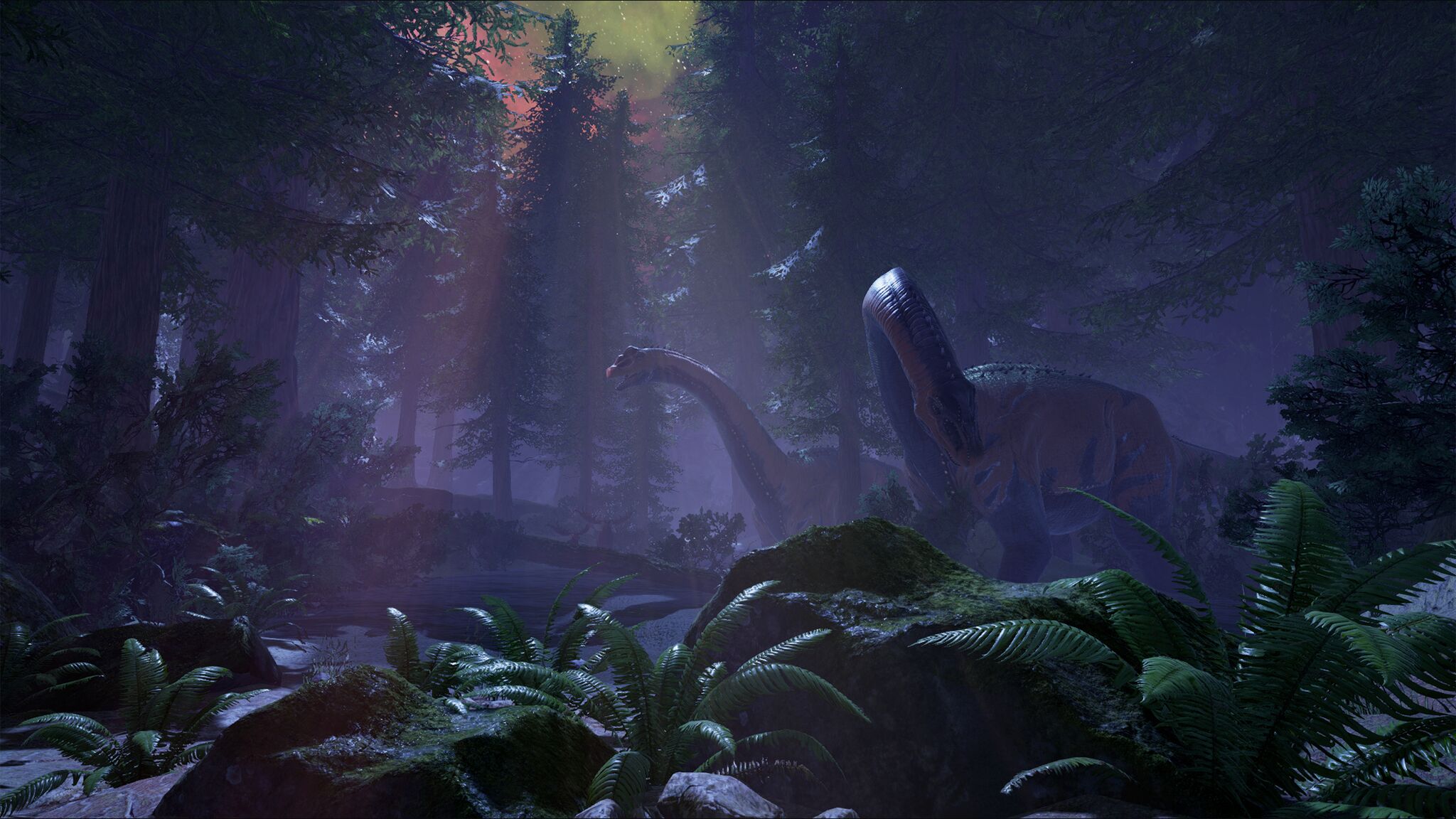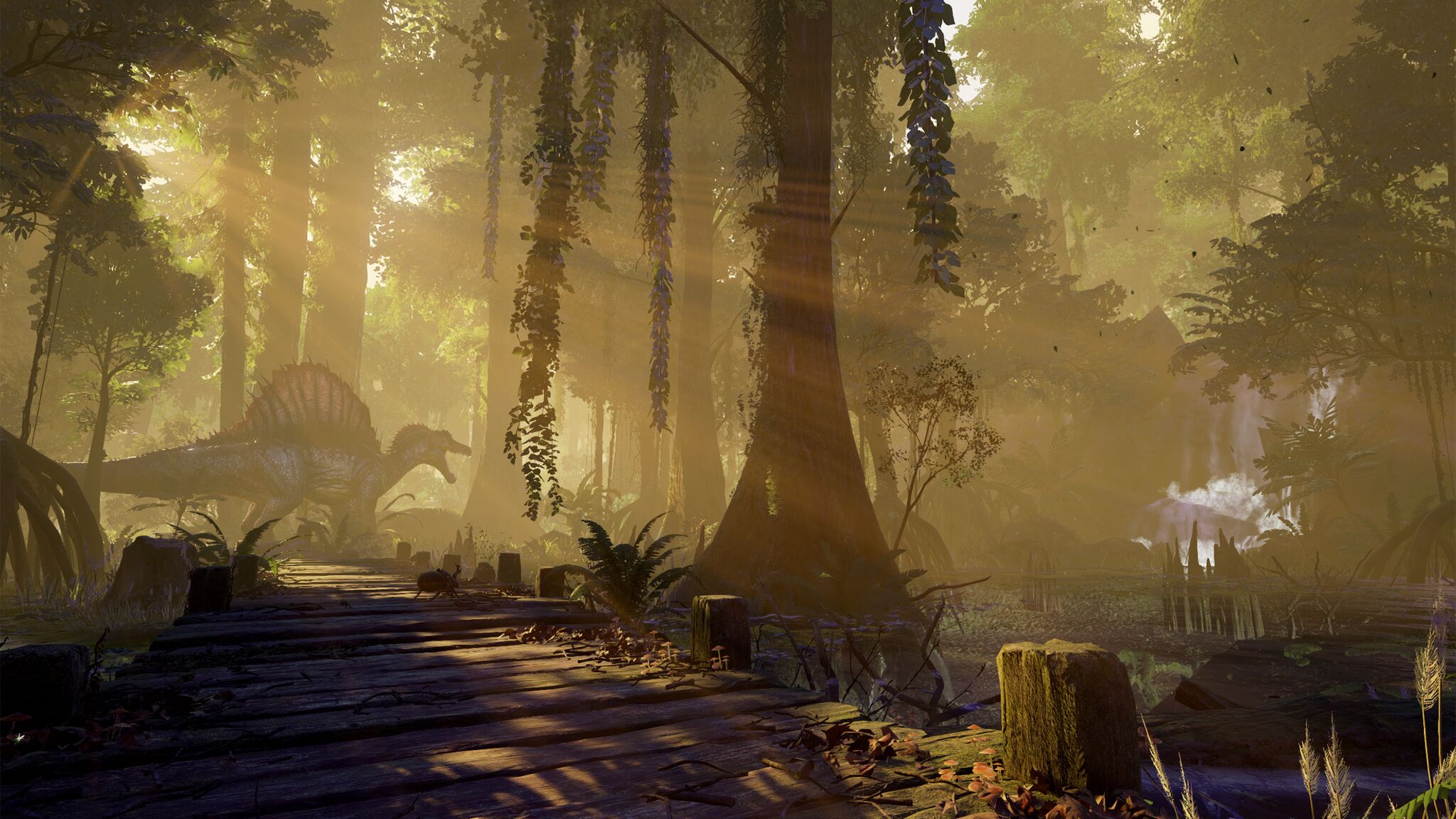'Ark Park' Features Steep Minimum Hardware Requirements, Pushes Visual Fidelity In VR (Updated)
Update - 3-6-2017, 6:26pm CT: A change was made to clarify the relationship between Snail Games and Studio Wildcard, and also to disclose new information concerning the PSVR port of the game.
Getting chased around by dinosaurs in VR can be an unnerving experience. We saw this with Ark: Survival Evolved and its subsequent expansions, which immersed users in a do-or-die, kill-or-be killed fight for your life on an island full of dinosaurs that can tear you to shreds. However, Ark: Survival was not designed explicitly as a VR experience, and the extremely high details of the environment and dinosaurs created performance issues for would-be survivors using HMDs (and sometimes, even standard 2D gamers).
Last November, Studio Wildcard licensed the IP for Ark: Survival Evolved to a company called Snail Games, which took all of the highly-detailed dinos from the suspenseful game and put them into a less-threatening package designed from the ground up specifically for VR. Ark Park lets you see all of the dinosaurs in their natural habitat, without the fear of getting eaten. You can even feed them.
At GDC, we had the opportunity to take a stroll through Ark Park, and we were impressed by the sheer detail of the dinosaurs and environment in the game. The downside to these stunning visuals was that the GTX 1080 running the game had its needle in the red the entire time, and we definitely weren’t hitting the standard 90fps most VR games are designed to deliver. The frame rate was mostly landing between 45-60fps (as best as we can tell from our personal VR gaming experience); the performance was a major downside to the otherwise-enjoyable demo.
We were shocked to learn that the minimum hardware requirements for Ark Park is an Intel Core i7-4790K processor and a GTX 1080 GPU, which up until last week, was Nvidia’s top-tier flagship graphics card. Furthermore, the recommended CPU is the eight-core Core i7-5960X, so it’s no wonder we experienced performance issues with such a steep hardware requirement.
Clearly, Snail Games and Studio Wildcard are banking on graphics technology improving sooner rather than later (and a GTX 1080 Ti would likely net better performance), with Ark Park slated for a 2017 release on Oculus Rift and HTC Vive. However, we are somewhat skeptical of how well a game requiring so much CPU and GPU horsepower will perform on the PSVR, which will also receive Ark Park sometime this year.
Although we’re elated to see more graphically demanding VR experiences, we wonder if Ark Park is pushing too much too fast. However, with AMD Vega on the way, and the GTX 1080 Ti offering a considerable performance boost over its predecessor, perhaps Ark Park will find a home in the game libraries of top-tier hardware enthusiasts. However, PSVR compatibility is somewhat of a wildcard, and the representatives we spoke with followed up our question about porting the game to the console shortly after GDC, simply offering that "we will optimize it fully to PSVR."
Get Tom's Hardware's best news and in-depth reviews, straight to your inbox.
Derek Forrest was a contributing freelance writer for Tom's Hardware. He covered hardware news and reviews, focusing on gaming desktops and laptops.
-
uglyduckling81 Also they could just implement some graphics options in a later build so anyone can play at what ever detail level is suitable to their machine. Right now it's showing just the best it has to offer. The fact that it requires bleeding edge to run top end graphics is a great thing in my opinion.Reply
I'm always sad to see recommended stats as a 970. No one is game to push the boundaries for fear of loss of potential sales.
The beauty of the PC is it's diversity to accommodate all budgets with hardware options and graphics settings. -
bit_user Reply
This is the right way to go, IMO. I wonder what game engine they're using, because most are pretty good about providing quality options to utilize high-end hardware, without locking out lower-spec systems.19390065 said:Also they could just implement some graphics options in a later build so anyone can play at what ever detail level is suitable to their machine.
Didn't sound like it. He quoted their minimum requirements spec, not just reporting what hardware they were using to demo it.19390065 said:Right now it's showing just the best it has to offer. The fact that it requires bleeding edge to run top end graphics is a great thing in my opinion.
However, with AMD Vega on the way, and the GTX 1080 Ti offering a considerable performance boost over its predecessor, perhaps Ark Park will find a home in the game libraries of top-tier hardware enthusiasts.
Would be interesting to know if it supports multi-GPU. If you get a chance, please ask. I'm interested in how many VR games start enabling this avenue. -
gamebrigada Ark uses UE4 which I would assume is what Ark Park will use since they are recycling a TON of work from it. UE4 is also a pretty natural choice in VR for high fidelity games.Reply
I doubt they will have much trouble running it on PSVR, UE4 allows Ark to run on basically anything including a potato with reasonable graphics, although the harder you push it the more beautiful it looks. Don't forget that UE4 can scale as far back as an iphone/android phone and still look decent.
Ark also has a bit to go in terms of optimization, they are really struggling with the balance of beauty and long range in Ark. UE4 wasn't quite the best choice for such an incredible open world game. -
cryoburner "we will optimize it fully to PSVR."Reply
As opposed to not optimizing it at all for the PC? >_>
Really, if the minimum requirements include a $500 graphics card and a $350 processor on top of an expensive VR headset, I can't help but think they're going to have a hard time selling the game on the PC. Especially since this seems to be more of a casual gaming experience than something targeting the more "core" gaming audience that might be more likely to own that kind of hardware. If they can optimize the game to run in VR at 60+fps on a PS4, there's no excuse for them to not provide similar graphics options to enable sub-$200 "vr capable" CPUs and GPUs to run the game on the PC. Maybe they are intending to enable lower graphics settings, and were just listing the requirements to run the game using ideal settings, but they didn't make it sound that way.
And of course, the recommended requirements include a $1000+, 8-core i7-5960X, something very few gaming PCs will actually have. It does make me wonder if the game will be optimized to make use of more cores though. If that's the case, then the newly-launched 8-core Ryzen CPUs might see some advantage at a markedly lower price, as could the upcoming 6-core Ryzens. -
bak0n The hardware requirements are probably higher than that, but since better GPU hardware didn't exist they just put it in. It probably runs like crap on a 4 way SLI 1080 set up as well. ARK isn't known for being well optimized.Reply -
Dejey Likely with my 980 I can't even try this right now, and won't for 16-24 months(when my planed GPU upgrade is) still I am super happy to see VR get its limits pushed. Even if I flops I can see this being the "crysis" of PCVR. How many fps can you dig get!? HahaReply -
grimfox I've yet to see a game support multiGPU VR. I'd get it if this game were a year or two out and their minimum spec was that high today. But it seems like they are closer to launch than that.Reply

